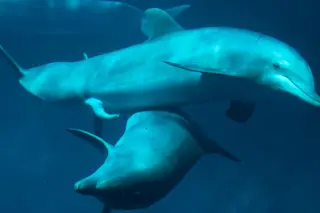Perhaps the hardest part about studying marine mammal reproductive anatomy using organs collected from deceased animals is that they can’t get an erection the easy way.
Reinflating human penises postmortem is a relatively trivial feat, says Diane Kelly, a research assistant professor at University of Massachusetts and penis inflation expert. Like most mammals, human penises are mostly fleshy, with lots of vascular space for blood to flow into to make the flaccid structure rigid with turgor pressure. But whale and dolphin penises are a lot tougher — quite literally.
“It’s actually a real challenge to artificially inflate cetacean penises,” she told me. Yes, the size makes things difficult — it takes a lot more saline to fill a large penis than a small one — but it’s more than that. “They have what’s called a ‘fibroelastic’ penis,” she explained, which means their penile tissue contains “a lot of collagen, and ...














